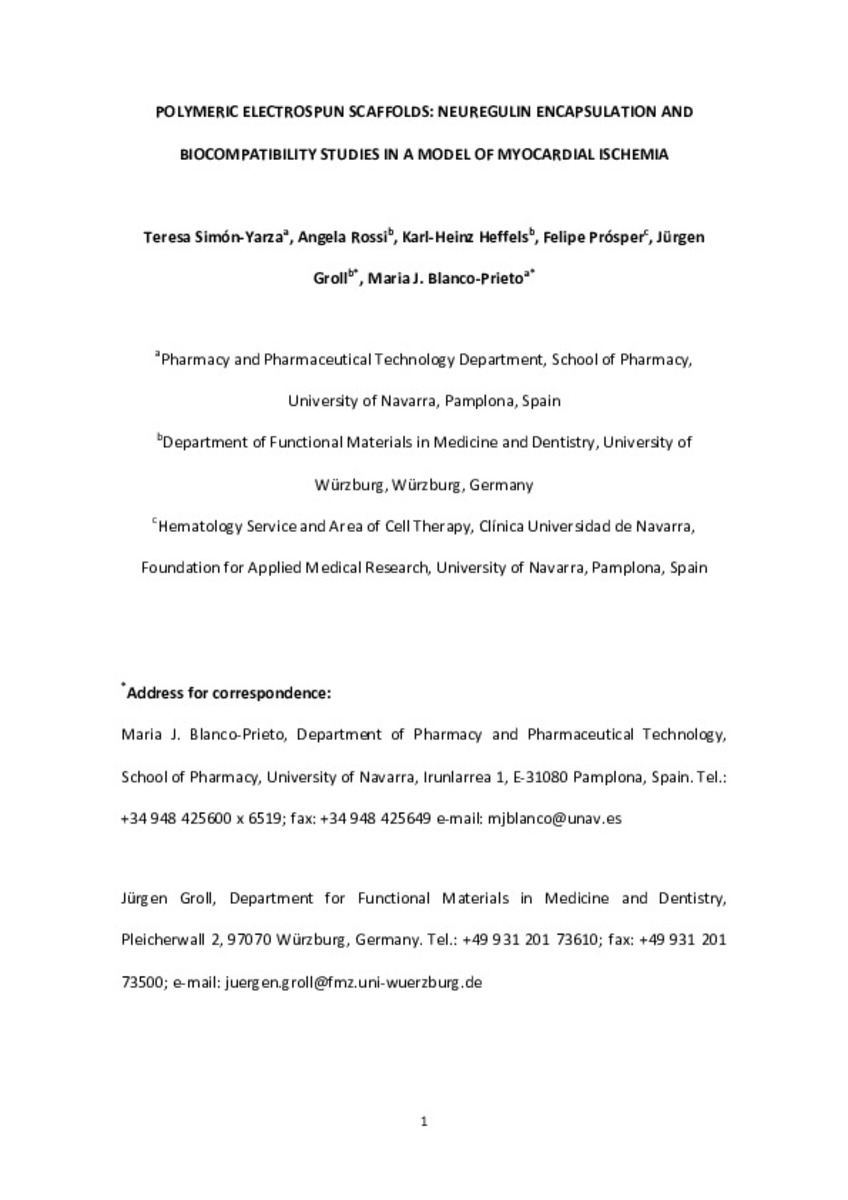Full metadata record
| DC Field | Value | Language |
|---|---|---|
| dc.creator | Simon-Yarza, T. (Teresa) | - |
| dc.creator | Rossi, A. (Ángela) | - |
| dc.creator | Heffels K.H. (Karl‐Heinz) | - |
| dc.creator | Prosper-Cardoso, F. (Felipe) | - |
| dc.creator | Groll, J. (Jürgen) | - |
| dc.creator | Blanco-Prieto, M.J. (María José) | - |
| dc.date.accessioned | 2016-03-01T13:05:17Z | - |
| dc.date.available | 2016-03-01T13:05:17Z | - |
| dc.date.issued | 2015 | - |
| dc.identifier.citation | Simón-Yarza T, Rossi A, Heffels K.H, Prósper F, Groll J, Blanco-Prieto M.J. Polymeric electrospun scaffolds: neuregulin encapsulation and biocompatibility studies in a model of myocardial ischemia. Tissue Eng Part A. 2015 March | es_ES |
| dc.identifier.issn | 1937-3341 | - |
| dc.identifier.uri | https://hdl.handle.net/10171/40090 | - |
| dc.description.abstract | Cardiovascular disease represents one of the major health challenges in modern times and is the number one cause of death globally. Thus, numerous studies are under way to identify effective cell‐ and/or growth factor‐based therapies for repairing damaged cardiac tissue. In this regard, improving the engraftment or survival of regenerative cells and prolonging growth factor exposure have become fundamental goals in advancing these therapeutic approaches. Biomaterials have emerged as innovative scaffolds for the delivery of both cells and proteins in tissue engineering applications. In the present study, electrospinning was used to generate smooth homogenous polymeric fibers, which consisted of a PLGA/NCO‐sP(EO‐stat‐PO) polymer blend encapsulating the cardioactive growth factor, Neuregulin‐1 (Nrg). We evaluated the biocompatibility and degradation of this Nrg‐containing biomaterial in a rat model of myocardial ischemia. Histological analysis revealed the presence of an initial acute inflammatory response after implantation, which was followed by a chronic inflammatory phase, characterized by the presence of giant cells. Notably, the scaffold remained in the heart after 3 months. Furthermore, an increase in the M2:M1 macrophage ratio following implantation suggested the induction of constructive tissue remodeling. Taken together, the combination of Nrg‐encapsulating scaffolds with cells capable of inducing cardiac regeneration could represent an ambitious and promising therapeutic strategy for repairing diseased or damaged myocardial tissue. | es_ES |
| dc.description.sponsorship | This work was partially supported by ISCIII‐RETIC RD12/0019/0031, MINECO PLE2009 ‐ 0116 CARDIOBIO, SAF2013 ‐ 42528 ‐ R,Program INNPACTO (PROCARDIO), European Union FPVII (INELPY), FUN (University of Navarra) Caja de Ahorros de Navarra (Programa Tu Eliges: Tu Decides). | es_ES |
| dc.language.iso | eng | es_ES |
| dc.publisher | Mary Ann Liebert | es_ES |
| dc.rights | info:eu-repo/semantics/openAccess | es_ES |
| dc.subject | Neuregulin | es_ES |
| dc.subject | Scaffold | es_ES |
| dc.subject | Tissue engineering | es_ES |
| dc.subject | Cardiovascular disease | es_ES |
| dc.subject | Biocompatibility | es_ES |
| dc.subject | Materias Investigacion::Ciencias de la Salud | es_ES |
| dc.title | Polymeric electrospun scaffolds: neuregulin encapsulation and biocompatibility studies in a model of myocardial ischemia | es_ES |
| dc.type | info:eu-repo/semantics/article | es_ES |
| dc.editorial.note | Final publication is available from Mary Ann Liebert, Inc., publishers http://dx.doi.org/10.1089/ten.tea.2014.0523 | es_ES |
| dc.identifier.doi | http://dx.doi.org/10.1089/ten.tea.2014.0523 | es_ES |
Statistics and impact
Items in Dadun are protected by copyright, with all rights reserved, unless otherwise indicated.






